
The kilogram is the base unit of mass in the International System of Units (SI), having the unit symbol kg. It is a widely used measure in science, engineering and commerce worldwide, and is often simply called a kilo colloquially. It means 'one thousand grams'.
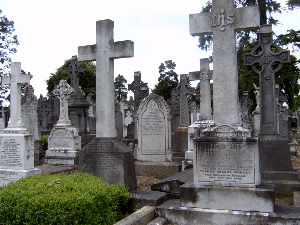
Glasnevin Cemetery is a large cemetery in Glasnevin, Dublin, Ireland which opened in 1832. It holds the graves and memorials of several notable figures, and has a museum.

A cemetery, burial ground, gravesite or graveyard is a place where the remains of dead people are buried or otherwise interred. The word cemetery implies that the land is specifically designated as a burial ground and originally applied to the Roman catacombs. The term graveyard is often used interchangeably with cemetery, but a graveyard primarily refers to a burial ground within a churchyard.

Burial, also known as interment or inhumation, is a method of final disposition whereby a dead body is placed into the ground, sometimes with objects. This is usually accomplished by excavating a pit or trench, placing the deceased and objects in it, and covering it over. A funeral is a ceremony that accompanies the final disposition. Evidence suggests that some archaic and early modern humans buried their dead. Burial is often seen as indicating respect for the dead. It has been used to prevent the odor of decay, to give family members closure and prevent them from witnessing the decomposition of their loved ones, and in many cultures it has been seen as a necessary step for the deceased to enter the afterlife or to give back to the cycle of life.

A grave is a location where a dead body is buried or interred after a funeral. Graves are usually located in special areas set aside for the purpose of burial, such as graveyards or cemeteries.
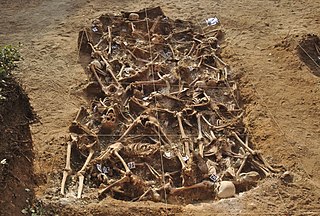
A mass grave is a grave containing multiple human corpses, which may or may not be identified prior to burial. The United Nations has defined a criminal mass grave as a burial site containing three or more victims of execution, although an exact definition is not unanimously agreed upon. Mass graves are usually created after many people die or are killed, and there is a desire to bury the corpses quickly for sanitation concerns. Although mass graves can be used during major conflicts such as war and crime, in modern times they may be used after a famine, epidemic, or natural disaster. In disasters, mass graves are used for infection and disease control. In such cases, there is often a breakdown of the social infrastructure that would enable proper identification and disposal of individual bodies.

The Killing Fields are a number of sites in Cambodia where collectively more than 1,000,000 people were killed and buried by the Khmer Rouge regime during its rule of the country from 1975 to 1979, immediately after the end of the Cambodian Civil War (1970–1975). The mass killings were part of a broad state-sponsored genocide.

Sonderaktion1005, also called Aktion1005 or Enterdungsaktion, was a top-secret Nazi operation conducted from June 1942 to late 1944. The goal of the project was to hide or destroy any evidence of the mass murder that had taken place under Operation Reinhard, the attempted extermination of all Jews in the General Government occupied zone of Poland. Groups of Sonderkommando prisoners, officially called Leichenkommandos, were forced to exhume mass graves and burn the bodies; inmates were often put in chains to prevent them from escaping.

In Chechnya, mass graves containing hundreds of corpses have been uncovered since the beginning of the Chechen wars in 1994. As of June 2008, there were 57 registered locations of mass graves in Chechnya. According to Amnesty International, thousands may be buried in unmarked graves including up to 5,000 civilians who disappeared since the beginning of the Second Chechen War in 1999. In 2008, the largest mass grave found to date was uncovered in Grozny, containing some 800 bodies from the First Chechen War in 1995. Russia's general policy to the Chechen mass graves is to not exhume them.

The Duraiappa stadium mass grave was discovered and excavated at the Duraiappah Sports Stadium in the formerly embattled northern city of Jaffna, Sri Lanka, during a period of relative calm between civil conflicts. The mass grave was unearthed in stages between April 4 and 10 of 1999.

The Vinnytsia massacre was the mass execution of between 9,000 and 11,000 people in the Ukrainian town of Vinnytsia by the Soviet secret police NKVD during the Great Purge in 1937–1938, which Nazi Germany discovered during its occupation of Ukraine in 1943. The investigation of the site first conducted by the international Katyn Commission coincided with the discovery of a similar mass murder site of Polish prisoners of war in Katyn. Nazi propaganda invoked mention of the massacre to illustrate communist terror by the Soviet Union.

Medlog is a settlement in the City Municipality of Celje in eastern Slovenia. It lies on the western outskirts of Celje. The grass runway of Celje Airport is located in the western part of the settlement. The area is part of the traditional region of Styria. It is now included with the rest of the municipality in the Savinja Statistical Region.

Kamniška Bistrica is a small dispersed settlement close to the source of the Kamnik Bistrica River in the Municipality of Kamnik in the Upper Carniola region of Slovenia.
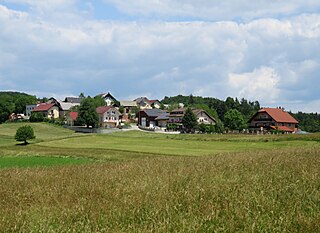
Pance is a settlement in the hills north of Grosuplje in central Slovenia. It belongs to the City Municipality of Ljubljana. The area is part of the traditional region of Lower Carniola. It is now included with the rest of the municipality in the Central Slovenia Statistical Region.
The 2011 Durango massacres were a series of mass murders that occurred in 2011. According to El Universal and Yahoo! News, at least 340 bodies have been found in mass graves around the city of Durango as of February 2012; These mass graves are the first of their kind in the state of Durango and third of their kind in Mexico. These mass graves had more bodies than the 2011 Tamaulipas massacre of 189 bus passengers. Since April 2011, there have been seven mass graves found around Durango. One of these mass graves was found in a vacant auto repair lot in Durango with 89 bodies. One of the bodies identified was Alfonso Peña, the former mayor of Tepehuanes Municipality, Durango.
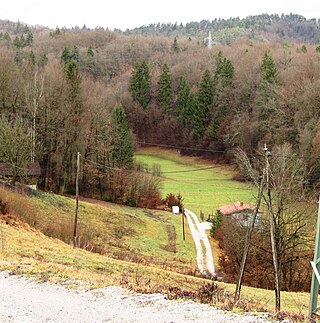
The Kucja Valley is a blind valley on the outskirts of Ljubljana, central Slovenia. Administratively, it belongs to the Dravlje District. The name may be derived from Slovene kucelj 'hill, rise', referring to the terminus of the valley. Geologically, it lies at the conjunction of a more gravelly layer with a more compact limestone layer.

The St. Stanislaus Institute is a Slovenian Roman Catholic educational institution in Šentvid, Ljubljana. Its origins date back to the end of the 19th century, when Ljubljana Bishop Anton Bonaventura Jeglič presented the idea of creating the first fully Slovene-language upper secondary school. After many complications involving the city authorities' refusal to grant permission for construction in the center of the city, on 16 July 1901 Jeglič blessed the newly laid cornerstone of the institute. Construction lasted four years. The bishop blessed the building on 21 September 1905 and it was named after Saint Stanislaus Kostka.
The Coahuila mass graves was the mass murder of 38 people near the city of Piedras Negras, Coahuila, Mexico on 3 June 2011. The three clandestine mass graves where the bodies were exhumed were found by the Mexican military and authorized personnel after an anonymous call notified them of the location where the decaying bodies were. The investigators found buttons, shirts, coins, and watches. The mass graves were purposely covered with soil and grass to simulate a pasture. All of the bodies were burned to death.
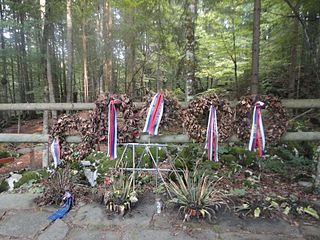
Mass graves in Slovenia were created in Slovenia as the result of extrajudicial killings during and after the Second World War. These clandestine mass graves are also known as "concealed mass graves" or "silenced mass graves" because their existence was concealed under the communist regime from 1945 to 1990.

















